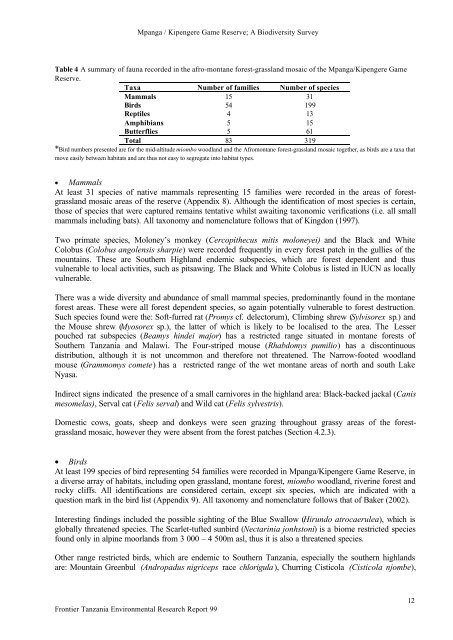Mpanga/Kipengere Game Reserve - Frontier-publications.co.uk
Mpanga/Kipengere Game Reserve - Frontier-publications.co.uk
Mpanga/Kipengere Game Reserve - Frontier-publications.co.uk
You also want an ePaper? Increase the reach of your titles
YUMPU automatically turns print PDFs into web optimized ePapers that Google loves.
<strong>Mpanga</strong> / <strong>Kipengere</strong> <strong>Game</strong> <strong>Reserve</strong>; A Biodiversity Survey<br />
Table 4 A summary of fauna re<strong>co</strong>rded in the afro-montane forest-grassland mosaic of the <strong>Mpanga</strong>/<strong>Kipengere</strong> <strong>Game</strong><br />
<strong>Reserve</strong>.<br />
Taxa Number of families Number of species<br />
Mammals 15 31<br />
Birds 54 199<br />
Reptiles 4 13<br />
Amphibians 5 15<br />
Butterflies 5 61<br />
Total 83 319<br />
*Bird numbers presented are for the mid-altitude miombo woodland and the Afromontane forest-grassland mosaic together, as birds are a taxa that<br />
move easily between habitats and are thus not easy to segregate into habitat types.<br />
• Mammals<br />
At least 31 species of native mammals representing 15 families were re<strong>co</strong>rded in the areas of forestgrassland<br />
mosaic areas of the reserve (Appendix 8). Although the identification of most species is certain,<br />
those of species that were captured remains tentative whilst awaiting taxonomic verifications (i.e. all small<br />
mammals including bats). All taxonomy and nomenclature follows that of Kingdon (1997).<br />
Two primate species, Moloney’s monkey (Cer<strong>co</strong>pithecus mitis moloneyei) and the Black and White<br />
Colobus (Colobus angolensis sharpie) were re<strong>co</strong>rded frequently in every forest patch in the gullies of the<br />
mountains. These are Southern Highland endemic subspecies, which are forest dependent and thus<br />
vulnerable to local activities, such as pitsawing. The Black and White Colobus is listed in IUCN as locally<br />
vulnerable.<br />
There was a wide diversity and abundance of small mammal species, predominantly found in the montane<br />
forest areas. These were all forest dependent species, so again potentially vulnerable to forest destruction.<br />
Such species found were the: Soft-furred rat (Promys cf. delectorum), Climbing shrew (Sylvisorex sp.) and<br />
the Mouse shrew (Myosorex sp.), the latter of which is likely to be localised to the area. The Lesser<br />
pouched rat subspecies (Beamys hindei major) has a restricted range situated in montane forests of<br />
Southern Tanzania and Malawi. The Four-striped mouse (Rhabdomys pumilio) has a dis<strong>co</strong>ntinuous<br />
distribution, although it is not un<strong>co</strong>mmon and therefore not threatened. The Narrow-footed woodland<br />
mouse (Grammomys <strong>co</strong>mete) has a restricted range of the wet montane areas of north and south Lake<br />
Nyasa.<br />
Indirect signs indicated the presence of a small carnivores in the highland area: Black-backed jackal (Canis<br />
mesomelas), Serval cat (Felis serval) and Wild cat (Felis sylvestris).<br />
Domestic <strong>co</strong>ws, goats, sheep and donkeys were seen grazing throughout grassy areas of the forestgrassland<br />
mosaic, however they were absent from the forest patches (Section 4.2.3).<br />
• Birds<br />
At least 199 species of bird representing 54 families were re<strong>co</strong>rded in <strong>Mpanga</strong>/<strong>Kipengere</strong> <strong>Game</strong> <strong>Reserve</strong>, in<br />
a diverse array of habitats, including open grassland, montane forest, miombo woodland, riverine forest and<br />
rocky cliffs. All identifications are <strong>co</strong>nsidered certain, except six species, which are indicated with a<br />
question mark in the bird list (Appendix 9). All taxonomy and nomenclature follows that of Baker (2002).<br />
Interesting findings included the possible sighting of the Blue Swallow (Hirundo atrocaerulea), which is<br />
globally threatened species. The Scarlet-tufted sunbird (Nectarinia jonhstoni) is a biome restricted species<br />
found only in alpine moorlands from 3 000 – 4 500m asl, thus it is also a threatened species.<br />
Other range restricted birds, which are endemic to Southern Tanzania, especially the southern highlands<br />
are: Mountain Greenbul (Andropadus nigriceps race chlorigula), Churring Cisti<strong>co</strong>la (Cisti<strong>co</strong>la njombe),<br />
<strong>Frontier</strong> Tanzania Environmental Research Report 99<br />
12

















